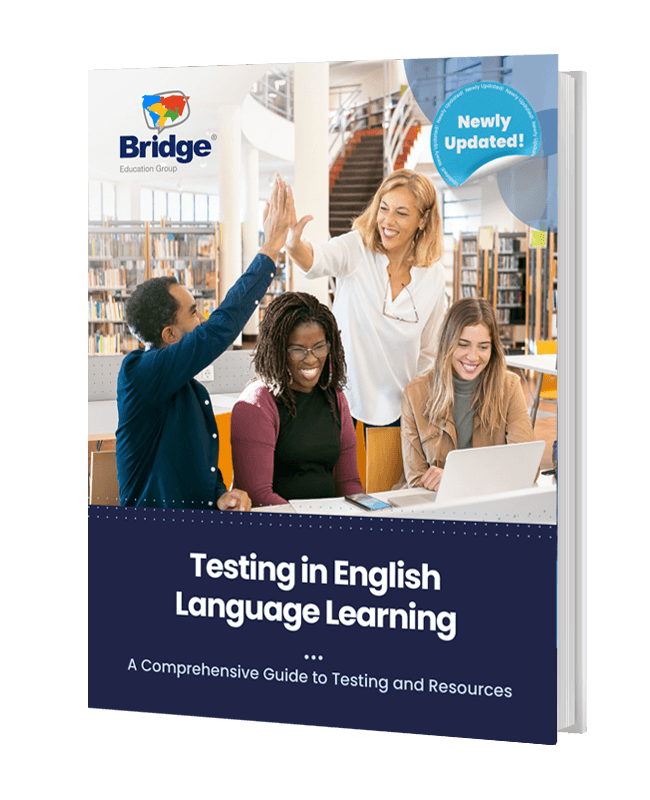When it comes to describing a student’s English abilities, their skills could fall anywhere from being able to offer a basic greeting to sounding like a native speaker. So, how can you determine how well a student uses English? Let’s break down the different English language learner levels used to measure and describe a student’s command of English. Specifically, let’s look at the levels outlined by a widely used standard called the CEFR, as well as additional methods of language assessment, like the GSE, that are growing in popularity.
New to TEFL? Get initial training and qualification with a TEFL certificate. You can explore our online TEFL courses to get started!
What is an ELL level of proficiency?
To gauge an English language learner’s (ELL’s) capabilities and place them in the appropriate class level, language institutions must identify a student’s level of proficiency. This is generally based on a scale that ranges from beginner to advanced (or native-speaker level). Understanding your student’s level of proficiency at the beginning and end of instruction is a critical means of measuring your teaching effectiveness. It can also be used for finding ways to better attune material to meet students’ learning goals.
Whether it’s for assessing young learners or adults, each proficiency level gives a general picture of an ELL’s skills. Proficiency measures speaking, reading, writing, and overall comprehension of the language. For instance, each description gives a teacher and the students an idea of the vocabulary range they have. This can include situations they can proficiently use English in and the topics they can talk about. Remember, language fluency is different from proficiency. Both will vary from student to student based on a myriad of factors ranging from age to experience level. Using a common framework, like the CEFR or the GSE, is just one of many tools teachers have at their disposal.

Why is it important for teachers and students to be aware of English language learners’ proficiency levels?
Knowing the levels of English language learners is crucial for the following reasons:
-
It gives the English teacher an idea of what the student may or may not be capable of doing in class right from the start of a course.
-
A teacher can determine a learner’s needs and establish goals with the language, based on their current level.
-
Teachers can select the materials and activities appropriate to the learner’s level and tailor their teaching techniques.
-
Learners can create their own English learning goals after they find out their present level of proficiency.
-
Learners can also see if they’re making headway as they progress through their English studies.
What is the CEFR (Common European Framework of Reference for Languages)?
While many standards exist to measure a language learner’s proficiency level, the CEFR provides the most widely accepted descriptions. The Common European Framework of Reference for Languages (CEFR) is accepted as a standard by universities, governments, and businesses across the globe. Created by the Council of Europe, the CEFR is not English-specific. Instead, the CEFR uses neutral language that can be applied to students of any language.
CEFR language levels provide universally understood descriptions that are recognized in academics, by language schools, and by textbook publishers as standard. The CEFR scale is also used professionally on resumes, during job recruitment, and by companies promoting their employees.
Interested in learning about ways to use assessments in your instruction? Read about leveraging English proficiency testing in the classroom.
Take a deep dive into the spectrum of English language exams and resources with the free guide to
Testing in English Language Learning
DownloadWhat are the CEFR levels of English proficiency?
The CEFR scale is organized into six different language levels of proficiency, from A1 to C2, which are divided into three broader English language learner levels: Basic User, Independent User, and Proficient English User. Here’s a closer look at each of the CEFR levels and how students can accomplish them.
Basic User
A1 (Beginner)
If students are at the A1 language level, they have a basic grasp of the English language. They can give a self-introduction and respond to simple questions such as, “Where are you from?” or, “How old are you?” As long as the other person talks slowly and clearly, they will be able to interact using isolated words or short phrases. When gauging English proficiency levels, it’s important to remove bias from the evaluation; every student starts at the beginning, so some adult students may be communicating at a child’s level for a native speaker.
A2 (Elementary)
Learners in the A2 level are those who can communicate using full sentences, a wider array of vocabulary words, and common expressions related to topics that are simple and relevant to them. For instance, they can speak and answer questions about their family or places in their neighborhood, although they may still require others to speak slowly during a conversation.
Independent User
B1 (Intermediate)
At the B1 language level, students can already talk more about familiar topics like their hobbies, personal interests, or education. Moreover, they can use the language in more situations such as traveling, dining out, or socializing. At this point, they’re also able to describe their experiences, dreams, and plans, as well as express their opinions in uncomplicated terms. There can sometimes be a disconnect when determining intermediate-level meaning regarding language evaluation. The CEFR takes this into account and is very specific about what constitutes beginner, intermediate, and upper intermediate.
B2 (Upper Intermediate)
Once students reach the B2 level, they’re more fluent when it comes to conveying their thoughts. Students will be able to comment on various concrete and abstract topics, such as cultural and political issues. They can also take part in meetings in their area of expertise and even converse with native speakers. Of all the ESL levels being discussed, the B2 Upper Intermediate is one of the broadest categories within the CEFR. This level can span a wide range of subjects and responses but signifies a major step in learning a language.

Proficient User
C1 (Advanced)
Students’ English skills at the C1 language level are already considered advanced, which means they can understand and coherently use complex grammar structures in written and spoken form. They also have a firmer understanding of longer texts and can identify implicit meaning. At this level, learners are also comfortable using English in school, work, social activities, and almost all other kinds of situations. A learner at this level will benefit greatly from long-term projects and learning goals as they will likely be able to identify gaps in their own knowledge.
C2 (Proficient)
The highest level in the CEFR scale is C2, which is close to native English speaker proficiency. When students reach this level, it means they can communicate very fluently and precisely even if it’s about complex topics like science and finance. They can easily understand almost everything they hear or read in English, regardless of another speaker’s pacing and word choice or the complexity of vocabulary in a text. This level of English proficiency allows for more subtle linguistic learning opportunities such as regional accent development and the use of cultural idioms.
What level of English is fluent?
In addition to identifying English language proficiency, it’s important to explain what the difference is between fluency and proficiency. The most important takeaway is that proficiency is concerned with accuracy. For a student to be proficient in a language, they must understand and use the correct terminology, grammar, and phrasing in the non-native language.
Fluency, however, is the smoothness with which a student can communicate. It is comprised of pronunciation, articulation, and the rate at which a student can communicate a coherent thought. Fluency is a nuanced topic; a student can be fluent but not proficient or vice versa. Fluency generally progresses as proficiency improves but can be affected by a student’s age, experience level, and instruction method.
Moreover, language levels of fluency are not always linear! They can rise and fall as learning objectives become more complex. Understanding the differences in fluency vs. accuracy can help you find the balance between teaching fluency and accuracy.
Learn more about how long it takes to learn a language.
How are CEFR English language learner levels determined?
As it merely provides universal guidelines to describe language learning levels, the CEFR isn’t a test. However, language learners can find out their place on the CEFR in a number of ways. Here are some examples of language-level evaluations students can take.
Placement tests
The best and quickest way for ELLs to find out their CEFR level is by taking a placement test given by an English language school or institute. It’s also necessary to take this assessment if you want to take an English language course or if you want to find out your progress during your English studies.
Take note that placement tests may vary from one school to another.
Standardized English proficiency exams
Learners can also take high-quality, standardized English proficiency tests, especially if they need to demonstrate their English level for academic, work, or immigration purposes. As these language exams are more comprehensive than placement tests in language schools, test takers often take an exam prep course beforehand.
-
The Business Language Testing Service (BULATS)
Although these standardized English proficiency exams already have their own English learner levels, based on results, students can also see what their test scores are equivalent to in the CEFR levels.
What is the Global Scale of English (GSE)?
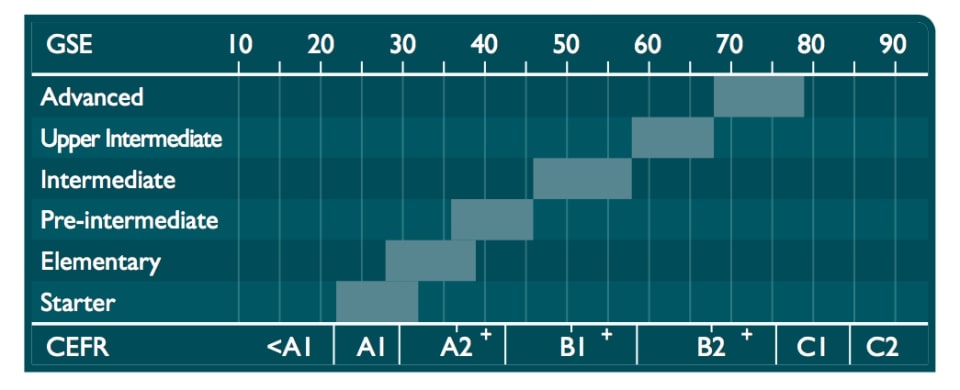
The Global Scale of English, or GSE, is a language learning framework designed by a world leader in language learning, Pearson Languages. The GSE is designed to guide each step of the language learning experience, from start to finish. This includes curriculum development, language assessment, and learning modules all the way through student proficiency testing. Based on a scale of 10-90, the GSE encapsulates goals and milestones for reading, writing, listening, and speaking. The English language learner levels within the GSE go beyond the CEFR to measure students’ progress on a more micro level. These modifications to English language learner levels make this evaluation method inclusive for learners worldwide.
Interested in teaching Pearson Test of English (PTE) prep? Check out this guide!
The GSE and the CEFR: Working together to provide an accurate level of proficiency
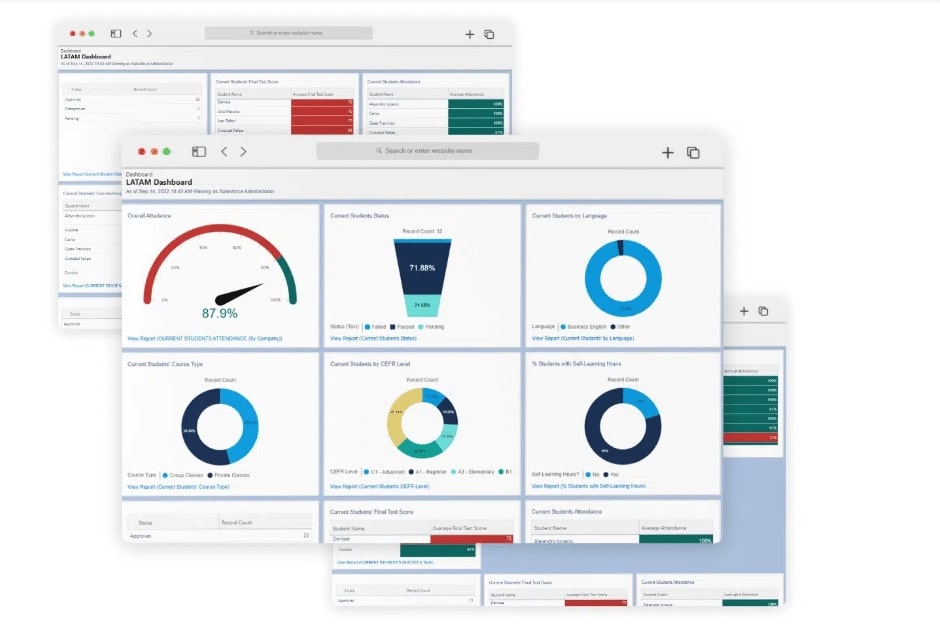
The GSE and the CEFR work hand in hand to provide an exceptionally detailed evaluation of student learning progress at each phase of their education. Using these tools in tandem allows for instructors to track micro-progressions in student learning that are often overlooked with broad standardized testing methods. Essentially, the CEFR categorizes and identifies fluency on its six-level scale, while the GSE specifies what a learner can do within each of those levels regarding speaking, reading, writing, and listening. The GSE was developed specifically with the CEFR in mind, so the levels of both systems map to each other.
Additionally, the CEFR was originally created to measure the progression of adult English language learners. The GSE accounts for young students as well and provides a baseline for their learning metrics to mesh with the widely accepted CEFR standards. For a more detailed examination of the methodology behind the creation of the GSE with respect to the CEFR, you can read Pearson’s white paper, Developing Global Scale of English Learning Objectives aligned to the Common European Framework, which explains in great detail the logic behind each of the English language learner levels within the GSE and their basis within the CEFR model.
Bridge Corporate Language Learning, the corporate language training branch of Bridge Education Group, leverages the GSE as a tool to interpret the test results of students in the language program and provide targeted learning goals as well as track language learning progress. Both the GSE and CEFR are integral parts of the language training program and tools for personalizing instruction by the program’s teachers of Business English.
Bridge Language Proficiency Levels
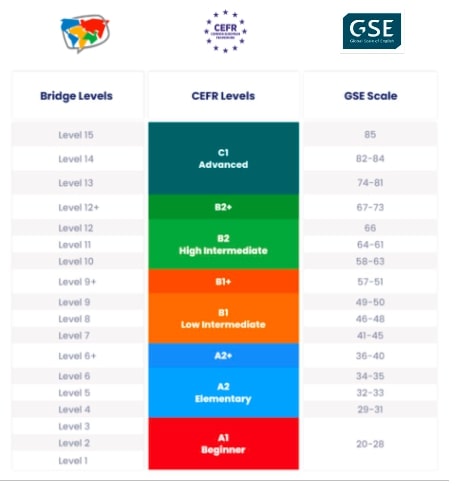
Additionally, Bridge Corporate Language Training has created a unique set of 18 Language Proficiency Levels based on the levels developed by the CEFR and the GSE.
Bridge levels were designed to guarantee recognition for a completed 45-hour module, celebrating trainees’ efforts and accomplishments and motivating them to continue learning. This, in turn, helps them avoid frustration from encountering significant plateaus in their learning.
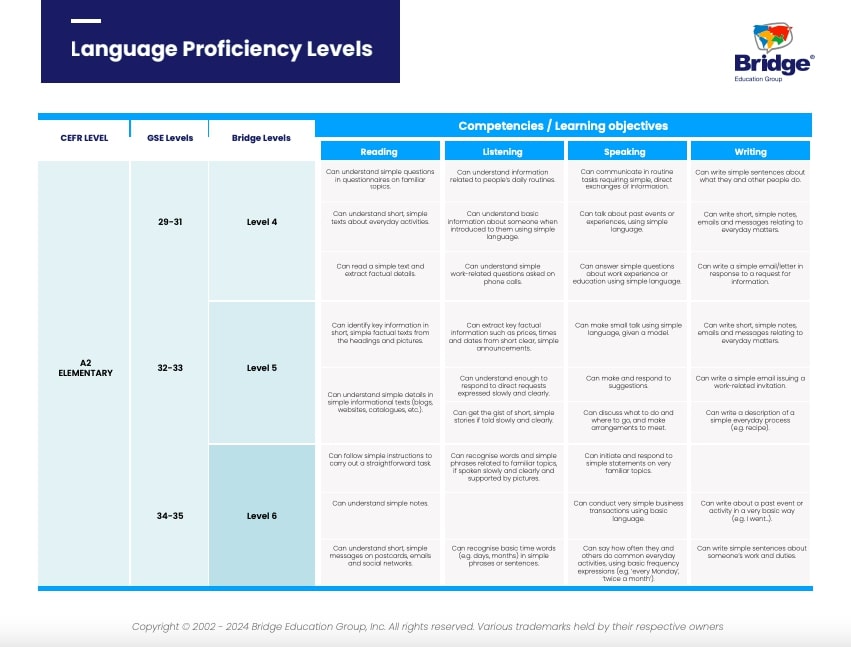
In order to document and celebrate progress in language proficiency, Bridge has also developed digital badges that are backed by Blockchain technology. These badges allow companies to measure the results of their training and support students in understanding the meaning behind their results.

Though every learner has a distinct experience with or prior knowledge of the language, it’s not impossible to measure proficiency using standardized levels. With the help of globally recognized standards, these level descriptions not only guide English teachers in their instruction but also help students take ownership of their language learning progress.






